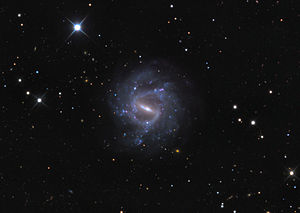NGC 1073
| Galaxie NGC 1073 | |
|---|---|
 | |
| Aufnahme mittels eines 24-Inch-Teleskops | |
| AladinLite | |
| Sternbild | Walfisch |
| Position Äquinoktium: J2000.0, Epoche: J2000.0 | |
| Rektaszension | 02h 43m 40,5s[1] |
| Deklination | +01° 22′ 34″[1] |
| Erscheinungsbild | |
| Morphologischer Typ | SB(rs)c[1] |
| Helligkeit (visuell) | 10,8 mag[2] |
| Helligkeit (B-Band) | 11,5 mag[2] |
| Winkelausdehnung | 4,9′ × 4,5′[1] |
| Positionswinkel | 15° |
| Flächenhelligkeit | 14,0 mag/arcmin²[2] |
| Physikalische Daten | |
| Zugehörigkeit | NGC 1068-Gruppe LGG 73[1][3] |
| Rotverschiebung | 0,004039 ± 0,000013[1] |
| Radialgeschwindigkeit | (1211 ± 4) km/s[1] |
| Hubbledistanz H0 = 73 km/(s • Mpc) | (55 ± 4) · 106 Lj (16,8 ± 1,2) Mpc [1] |
| Geschichte | |
| Entdeckung | William Herschel |
| Entdeckungsdatum | 9. Oktober 1785 |
| Katalogbezeichnungen | |
| NGC 1073 • UGC 2210 • PGC 10329 • CGCG 389-002 • MCG +00-08-001 • IRAS 02411+0109 • 2MASX J02434059+0122331 • GC 602 • H III 455 • HIPASS J0243+01 • LDCE 174 NED007 | |
NGC 1073 ist eine Balken-Spiralgalaxie vom Hubble-Typ SBc im Sternbild Walfisch (Cetus) südlich der Ekliptik. Sie ist schätzungsweise 54 Millionen Lichtjahre von der Milchstraße entfernt und hat einen Durchmesser von etwa 80.000 Lichtjahren.
Im selben Himmelsareal befinden sich u. a. die Galaxien NGC 1038, NGC 1043, IC 1827.
Am oberen linken Bildrand des Hubble-Bildes (unten), befindet sich eine ungefähr kreisförmige Region. Es handelt sich dabei um ein Gebiet, in der gerade neue Sterne entstanden sind. In der Struktur verbirgt sich eine helle Röntgenquelle namens IXO 5, die 2012 vom NASA-Röntgenteleskop Chandra entdeckt wurde. Dabei handelt es sich vermutlich um ein Schwarzes Loch, das von einem normalen Stern umkreist wird[4].
Die Typ-Ic-Supernova SN 1962L wurde hier beobachtet.[5]
Das Objekt wurde am 9. Oktober 1785 von William Herschel entdeckt.[6]
- (c) NASA & ESA, CC BY 4.0
Detailaufnahme des Hubble-Weltraumteleskops
Literatur
- König, Michael & Binnewies, Stefan (2019): Bildatlas der Galaxien: Die Astrophysik hinter den Astrofotografien, Stuttgart: Kosmos, S. 124
Weblinks
- astronews.com: Bild des Tages 31. Mai 2013
- astronews.com: Porträt einer Balkenspiralgalaxie 3. Februar 2012
Einzelnachweise
Auf dieser Seite verwendete Medien
Autor/Urheber: Credit Line and Copyright Adam Block/Mount Lemmon SkyCenter/University of Arizona, Lizenz: CC BY-SA 3.0 us
NGC 1073
Picture Details:
Optics 24-inch RC Optical Systems Telescope Camera SBIG STL11000 CCD Camera Filters Custom Scientific Dates December 12th and 16th 2009 Location Mount Lemmon SkyCenter Exposure LRGB = 165:60:50:70 minutes Acquisition ACP Observatory Control Software (DC-3 Dreams),TheSky (Software Bisque), Maxim DL/CCD (Cyanogen) Processing CCDStack (CCDWare), Mira (MiraMetrics), Maxim DL (Cyanogen), Photoshop CS3 (Adobe) Guest Astronomers: December 2009 Image Processing Workshop Participants and Mark WindsorCredit Line and Copyright Adam Block/Mount Lemmon SkyCenter/University of Arizona
(c) NASA & ESA, CC BY 4.0
The NASA/ESA Hubble Space Telescope has taken a picture of the barred spiral galaxy NGC 1073, which is found in the constellation of Cetus (The Sea Monster). Our own galaxy, the Milky Way, is thought to be a similar barred spiral, and the study of galaxies such as NGC 1073 can help astronomers learn more about our celestial home.


